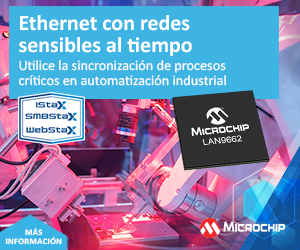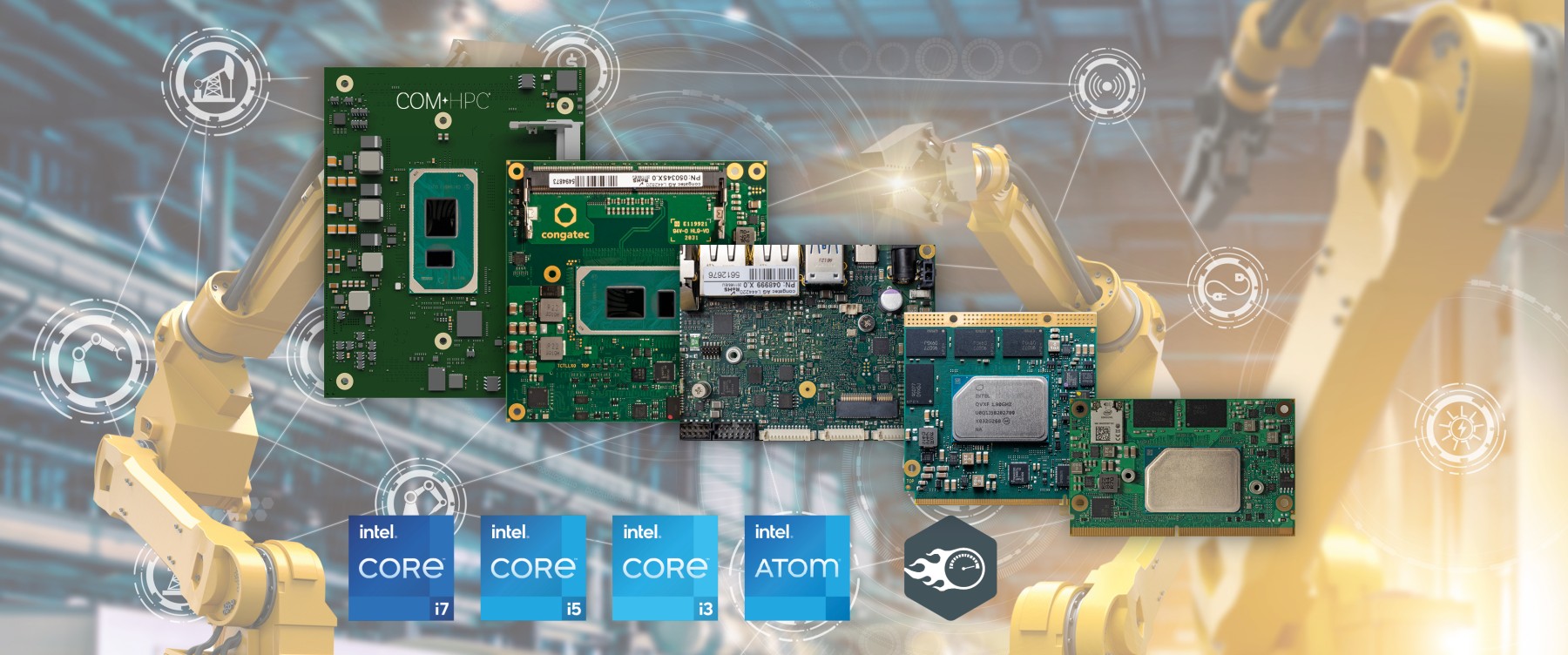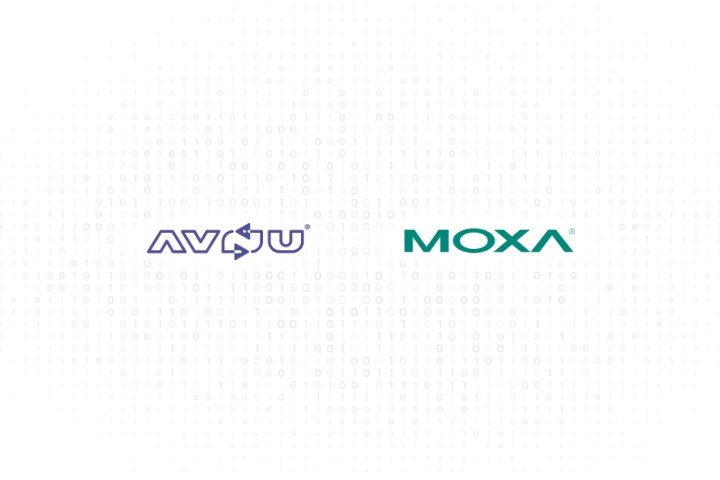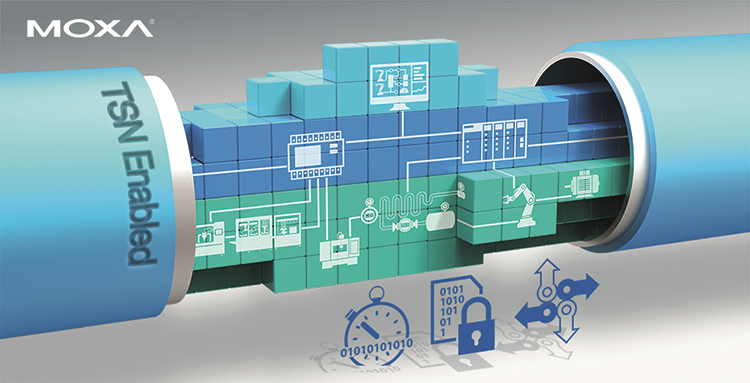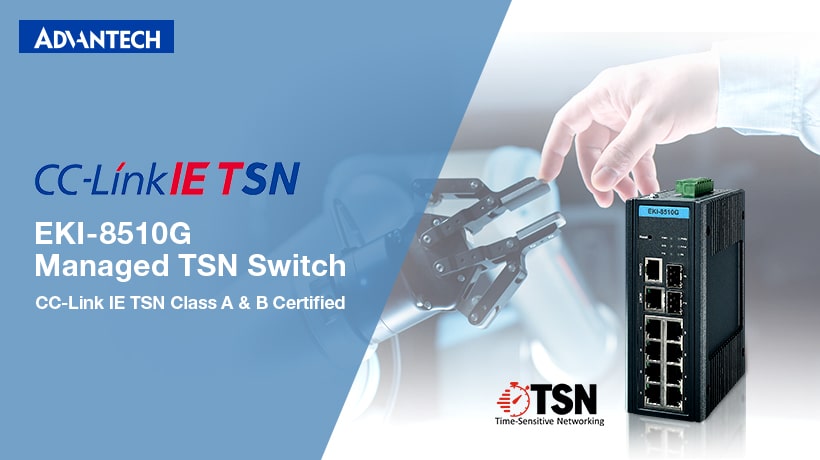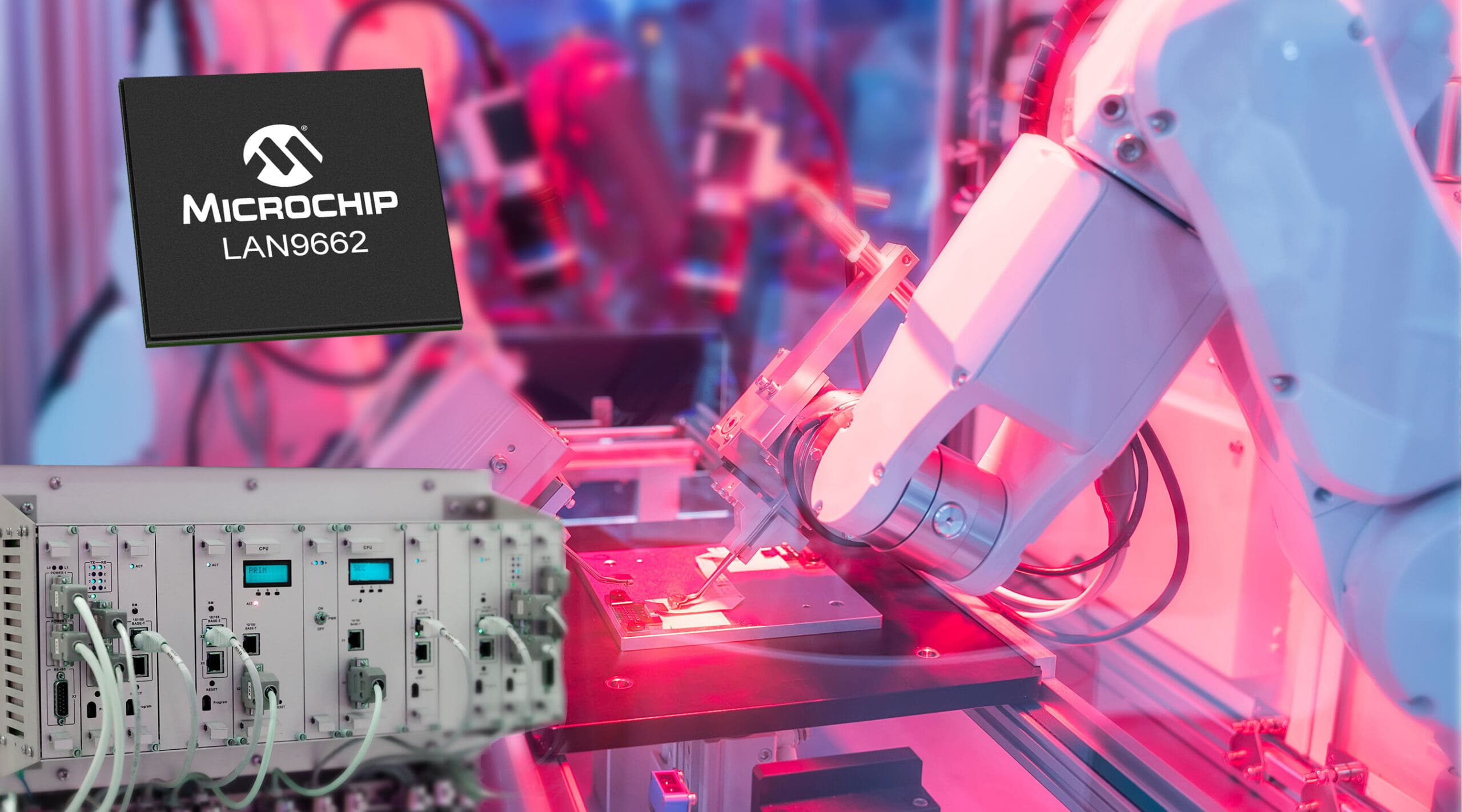Author Andreas Mangler, Director of Strategic Marketing of Rutronik
There are numerous fieldbus standards that claim to ensure real-time support, but none of them offer a vendor or platform independent network solution. An answer has been provided in the form of Time-Sensitive Networking (TSN). Still, mobile applications using real-time communication are possible when combined with 5G. The Fraunhofer Institute for Production Technology (IPT) and multiple mechanical engineering, robotics, and network engineering companies have recognized the potential of combining TSN with 5G. Together, they have developed a competent communication infrastructure with the aim of creating a highly available, reliable and secure communication solution for cloud-supported sensors and actuators. TSN provides real-time communications for wired systems, while 5G mobile technology manages all mobile and cloud connections.
One potential application could be in the precise control of a robot and tool, or two robots working together during live production. Data processing can be “outsourced” to the cloud using this infrastructure and the results are fed into the system, allowing robots in highly dynamic production systems to be controlled adaptively and flexibly, without the need to connect them directly to each other. . This works with devices from a multitude of manufacturers, even using existing machinery and facilities. There are many other scenarios that can also benefit from this combination, and some that may only be feasible with this constellation, including autonomous driving, transportation applications, and remote surgery.
TSN for Ethernet in real time
Let's first consider TSN, an evolution of standard Ethernet. Ethernet offers data communication services between devices of different brands for IT purposes, specifically in office environments. Industrial Ethernet is a more robust solution that is suitable in harsh environments. The special protocols EtherCAT, Profinet, and Modbus TCP also provide a more deterministic environment—in other words, data packets are transmitted or received at predictable times, thus eliminating the risk of data loss.
However, what Industrial Ethernet does not guarantee is real-time support. To this end, the IEEE 802.1 Task Group has developed a range of sub-standards that reference TSN. These standards define protocols for synchronization (IEEE 802.1AS), configuration (IEEE 802.1Qcc in particular) and traffic data control (Traffic Shaping and Scheduling, IEEE 802.1CB, 802.1Qbu and 802.1Qbv, among others). This means that there is a common plan that establishes when data packets are forwarded in a prioritized manner.
TSN does not cover the seven layers of the OSI model for network protocols, in which each layer defines how two systems communicate with specific tasks and functions. TSN addresses Layers 1 and 2 and the real-time aspect, which spans the entire vertical length of the model. This means that more protocols are required for the upper layers. Companies can continue to use their existing standards here, for example OPC UA. TSN provides the benefit of guaranteed real-time support without the need to adapt standards.
IT/OT interoperability and convergence
Thanks to open standards, TSN enables vendor-independent and platform-independent interoperability between different devices, machines and installations, similar to how standard Ethernet works in office IT applications. These standard Ethernet components can be integrated into TSN, allowing TSN to establish a consistent link between information technology (IT) and operational technology (OT) components. Critical and non-critical systems with different kinds of traffic can perform on the same network.
With bandwidths from 10 to 400 Gbit/s—compared to the 100 Mbit/s commonly seen in Industrial Ethernet networks—TSN also answers the demand for increased data volumes.
To date, only some of the TSN substandards have been ratified—others are still in the process of development. Still, existing standards can be implemented immediately—by ensuring real-time communication and being able to adapt to future standards.
Real-time support now available wirelessly thanks to 5G
5G helps expand real-time support for wireless networks via TSN globally. 5G not only supports ultra-low latency (ULL) and precise timing, but also brings vast improvements in reliability, range, and bandwidth over its predecessor technologies, all with superior power efficiency.
5G also makes it possible to create private networks that are inaccessible to the public. They bring benefits in performance, data protection and network security and, at the same time, provide quality of service (QoS). This is how 5G is laying the foundation for secure communication between a wide variety of machines and facilities, robots and components—from sensors and actuators to cloud services. Therefore, when developing a TSN network, it is recommended to consider the possibility of integrating 5G support to ensure that you have a scalable and future-proof solution.
Integrating 5G into a TSN network
A concept from the Research Group of the German Research Center for Artificial Intelligence (DFKI), the Technical University of Kaiserslautern and Nokia Bell Labs demonstrates how TSN synchronization (IEEE 802.1AS) can be integrated according to 5G standards (Figure 1). The 5G system consists of a 5G base station (gNB) and a network core 5G (5GC), as well as multiple end devices (UE), one of which (Reference UE) connects to the wired TSN network as part of the reference system. This device must support IEEE 802.1AS, so it can be synchronized with the TSN clock through the Grandmaster.
The 5G system also has its own synchronization mechanism, where each 5G base station (gNB) synchronizes networked end devices with it using the primary (PSS) and secondary (SSS) synchronization signals. End devices use these signals to identify their wireless cell and their radio frame; Using specific timing algorithms, they can adjust for frequency and time differences. Each incoming System Frame Number (SFN) is also paired with the reference end device time and transmitted to each connected end device. If OPC UA PubSub is used for distribution, it is possible to synchronize all end devices connected to the base station.
Synchronization between the base station and the connected end devices means that it is only necessary to identify the corresponding TSN time relative offset.

La Figure 2 provides an illustration of the layers of the message. User Datagram Protocol (UDP), along with Multicast, is used as the transport protocol, so each device in the Multicast group receives the subscribed messages.
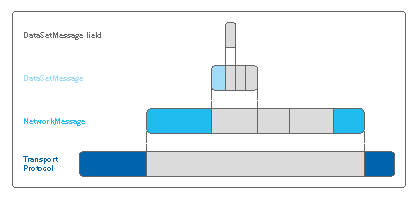
As the Figure 3, the research team successfully used this arrangement with a sync interval of 31,25 ms to achieve 350 ns synchronicity between an evaluation kit and an Intel NUC Mini PC.
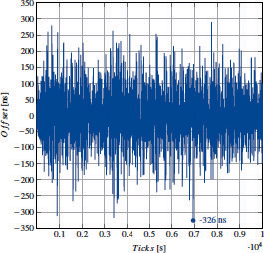
TSN evaluation and an Intel NUC Mini PC was 350 ns with an interval of
synchronization 31,25 ms.
Figure 3: The maximum offset in timing between the TSN evaluation kit and an Intel NUC Mini PC was 350 ns with a timing interval of 31,25 ms.
What does real time mean?
When guaranteeing real-time support in a network, the following characteristics are required:
Each device demands a precise internal clock, so each data packet can be recorded (date and time). All devices on the network need to be in sync.
Data packets are transmitted with very low latency, which means that they are subject to a very strict time limit. Critical applications (time-critical) require ultra-low latency (ULL) of a few milliseconds or even less than a millisecond, end-to-end, that is, from the time transmission begins until reception is complete.
High stability: Latency is always related to time variations called jitter (jitter). Some industrial control applications “prohibit” a jitter greater than a few microseconds, while others can handle delays of up to a millisecond.
Thus, stability and latency are also the most important parameters for the quality of service (QoS) of a ULL network.
Solution provider for TSN and 5G
All the products required to create a TSN and 5G infrastructure are found in the catalog of Rutronik. application engineers, product manager and line managers dealer are available to help with implementation.
Processors and cards supported by TSN
The Atom x6000E 10 nm processor from Intel and the Pentium and Celeron N- and J-series product lines have 2.5 GbE MACs with integrated TSN functions. Compared to the previous generation, they increase 1,7 times the performance single-threaded, up to 1,5 times the benefits multithreading and double the performance of GPU. UHD graphics support up to 4kp60 resolution on up to three displays simultaneously. Its Programmable Services Engine (PSE) with an ARM Cortex-M7 microcontroller offers independent processing power with low DMIP and I/O for IoT applications. They are also distinguished by a network proxy server, an embedded controller and a hub-sensor. For remote monitoring and management and firmware and software upgrade tasks, the processors provide in-band support via Wi-Fi or Ethernet; alternatively, out-of-band management over wired Ethernet is also possible.
There are numerous cards based on these Intel processors and from a wide variety of manufacturers available through Rutronik. The SMC-93 de Dry it is the first SMARC module specially developed for functional safety in critical systems.
Advantech it offers a SMARC 2.1 module with up to four cores and 40 percent more CPU performance, as well as higher GPU performance compared to previous models. The SOM-2532 It features two GbE LAN interfaces for real-time device communication TSN PHY and USB 3.2 Gen2 and PCIe Gen3. With CAN FD, it is possible to achieve data transfer speeds up to ten times faster – a very interesting aspect in applications with large amounts of data. The software WISE-DeviceOn from Advantech ensures that IoT devices operate stably and can be managed remotely. Therefore, SOM-2532 can be recommended in automotive, biomedical engineering, and transportation applications.
The 3.5” Single Board Computer (SBC) MIO-5152 from Advantech is also equipped with the latest Intel processors and WISE-DeviceOn from Advantech. It has 32 GB of DDR4-3200 and various interfaces such as HDMI 2.0/DP/LVDS, Dual GbE, four USB 3.2 sockets, four USB 2.0 sockets, six UART interfaces, and TPM support.
contron also offers a SMARC 2.1 module (SMARC-sXEL (E2)), as well as two COM Express models with TSN support (COMe-mEL10 (E2) COM Express mini Type 10 and COMe-cEL6 (E2) COM Express Compact Type 6). All three products come as versions with Intel Atom x6000E, Pentium or Celeron and have numerous interfaces.
In addition, a comparable card is available from DFI with Thin Mini-ITX format and Intel Atom X6000 processor.
Kontron has developed a ready-to-use TSN system—the KBox C-102-2 TSN Starter Kit includes CPI KBox C-102-2 and the PCIe-0400-TSN Gigabit Ethernet interface card with TSN support. The four network interfaces with switching function are based on standard Ethernet as specified by IEEE 802.3 and enable deterministic control applications in converged networks, from OT to IT, without the need for additional switches. The system ships with Realtime Linux and a network management tool so you can quickly set the parameters of a TSN network. Upgradable hardware and software open up the solution to new and evolved TSN standards. Applications span deterministic industrial control computers and servers, converged networks for critical and non-critical traffic, and security systems to protect deterministic traffic from malicious attacks.
5G cards, modems and antennas
Rutronik's product catalog also has a wide selection of hardware components for the development of 5G campus networks, including cards and modem 5G, as well as antennas. This offer includes one of the first 5G solutions available — the 5G-M.2 card. FN980 de Telit, which supports the global LTE and 5G sub-6 GHz bands. With a format of 30 × 50 mm and a temperature range of -40 to +85 °C, it is particularly suitable for use in industrial applications. The model FN980m also supports the new mmWave frequency bands above 30 GHz. Telit cards are based on the chipset Snapdragon X55 5G Qualcomm, just like the 5G-M.2 modules of the family AIW-355 from Advantech. Unlike Telit, Advantech is targeting specific versions for Europe, North America, and Japan with the AIW-355 family. With dimensions of 30 × 52 mm, it has a slightly larger format and a (reduced) temperature range of -10 to +55 °C. The 5G-M.2 cards from both manufacturers have multiple 5G and GNSS antenna sockets.
Rutronik offers several 5G antennas of 2J, AVX and PulseLarsen. SMD 5G antenna W3415 PulseLarsen's compact design supports all sub-6 GHz bands (4G and 5G) and measures only 40 × 7 × 3 mm. The Serie W3554 PulseLarsen's ultra-wideband dipole antennas with a frequency spectrum of 698 to 6000 MHz are ideal for both 5G applications and 2G, 3G, 4G, GNSS, Wi-Fi, Bluetooth, Bluetooth Low Energy, Zigbee and ISM bands of 868, 915, 2400 and 5000 MHz. The PCB antenna measures 30 × 120 × 0,2 mm.
To support the development of an internal campus network, Rutronik also supplies special 5G network components from FSP. They are ideal for supporting the deployment of base stations, access networks, data centers or individual network devices.
Whether it's 2G, 3G, 4G or 5G, with support for GNSS, Wi-Fi, Bluetooth and more, the PulseLarsen W3554 Ultra Wideband Dipole Antenna can do it all.
Conclusion
TSN takes the Ethernet standard to a new level of real-time communication. Supports a consistent, vendor-independent connection across IT and OT devices. 5G allows this opportunity to extend to mobile connections. The combination of both technologies provides the basis for collaborative robotics and reliable control of highly dynamic production systems, including mobile robots, as well as for freight transport systems, assisted and autonomous driving, remote surgery and augmented reality applications. (AR) and virtual (VR).



